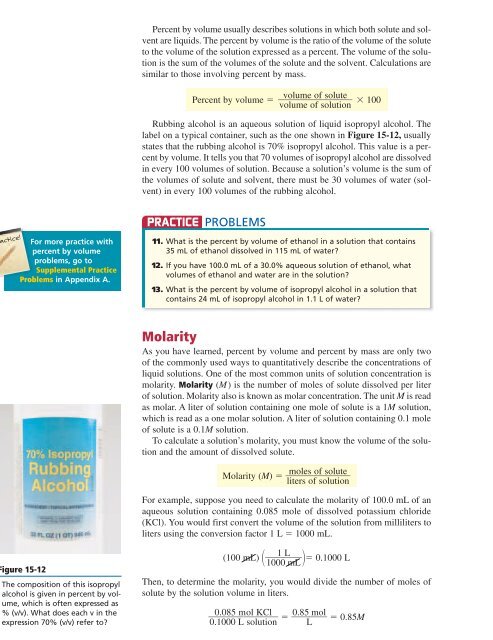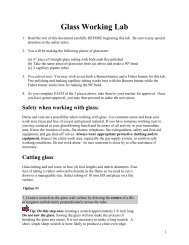Chapter 15: Solutions - Weironline.net
Chapter 15: Solutions - Weironline.net
Chapter 15: Solutions - Weironline.net
You also want an ePaper? Increase the reach of your titles
YUMPU automatically turns print PDFs into web optimized ePapers that Google loves.
Practice!<br />
For more practice with<br />
percent by volume<br />
problems, go to<br />
Supplemental Practice<br />
Problems in Appendix A.<br />
Figure <strong>15</strong>-12<br />
The composition of this isopropyl<br />
alcohol is given in percent by volume,<br />
which is often expressed as<br />
% (v/v). What does each v in the<br />
expression 70% (v/v) refer to?<br />
464 <strong>Chapter</strong> <strong>15</strong> <strong>Solutions</strong><br />
Percent by volume usually describes solutions in which both solute and solvent<br />
are liquids. The percent by volume is the ratio of the volume of the solute<br />
to the volume of the solution expressed as a percent. The volume of the solution<br />
is the sum of the volumes of the solute and the solvent. Calculations are<br />
similar to those involving percent by mass.<br />
Percent by volume �<br />
volume of solute<br />
�� � 100<br />
volume of solution<br />
Rubbing alcohol is an aqueous solution of liquid isopropyl alcohol. The<br />
label on a typical container, such as the one shown in Figure <strong>15</strong>-12, usually<br />
states that the rubbing alcohol is 70% isopropyl alcohol. This value is a percent<br />
by volume. It tells you that 70 volumes of isopropyl alcohol are dissolved<br />
in every 100 volumes of solution. Because a solution’s volume is the sum of<br />
the volumes of solute and solvent, there must be 30 volumes of water (solvent)<br />
in every 100 volumes of the rubbing alcohol.<br />
PRACTICE PROBLEMS<br />
11. What is the percent by volume of ethanol in a solution that contains<br />
35 mL of ethanol dissolved in 1<strong>15</strong> mL of water?<br />
12. If you have 100.0 mL of a 30.0% aqueous solution of ethanol, what<br />
volumes of ethanol and water are in the solution?<br />
13. What is the percent by volume of isopropyl alcohol in a solution that<br />
contains 24 mL of isopropyl alcohol in 1.1 L of water?<br />
Molarity<br />
As you have learned, percent by volume and percent by mass are only two<br />
of the commonly used ways to quantitatively describe the concentrations of<br />
liquid solutions. One of the most common units of solution concentration is<br />
molarity. Molarity (M) is the number of moles of solute dissolved per liter<br />
of solution. Molarity also is known as molar concentration. The unit M is read<br />
as molar. A liter of solution containing one mole of solute is a 1M solution,<br />
which is read as a one molar solution. A liter of solution containing 0.1 mole<br />
of solute is a 0.1M solution.<br />
To calculate a solution’s molarity, you must know the volume of the solution<br />
and the amount of dissolved solute.<br />
Molarity (M) ��<br />
moles<br />
o<br />
�<br />
f solute<br />
liters<br />
of solution<br />
For example, suppose you need to calculate the molarity of 100.0 mL of an<br />
aqueous solution containing 0.085 mole of dissolved potassium chloride<br />
(KCl). You would first convert the volume of the solution from milliliters to<br />
liters using the conversion factor 1 L � 1000 mL.<br />
��<br />
(100 mL) �� 1 L<br />
� 0.1000 L<br />
1000<br />
mL<br />
Then, to determine the molarity, you would divide the number of moles of<br />
solute by the solution volume in liters.<br />
0.<br />
085<br />
mol<br />
KCl<br />
�� � �<br />
0. 1000<br />
L solution<br />
0.85<br />
�<br />
mol<br />
� 0.85M<br />
L




